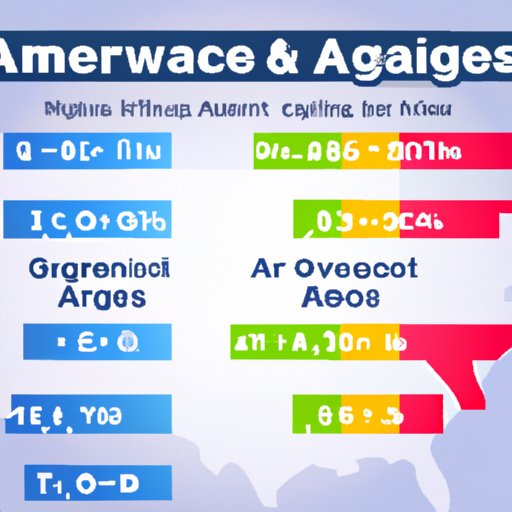Introduction
The question of how much does an average American make a year has been asked for decades. With the cost of living continuing to rise, it’s important to understand the average income in the US and the factors that can influence it. This article will explore the average American income, breaking down median household incomes across the country, examining the potential earning potential of various jobs and job sectors, comparing American incomes to those of other countries, analyzing the gender wage gap in the US, exploring the link between education level and earnings, investigating how taxes impact the net income of Americans, and looking into the relationship between geography and wages.

Breaking Down the Median Household Income in the US
According to the US Census Bureau, the median household income in 2019 was $68,703. This figure is slightly higher than the 2018 median household income of $63,179. The median household income varies significantly by state, with some states having incomes that are much higher than the national median. For example, the median household income in Maryland in 2019 was $83,242, while the median household income in Mississippi was only $45,936.
Regional differences also play a role in the median household income. According to a report from the US Census Bureau, the median household income in the Northeast in 2019 was $71,919, the highest of any region in the US. The median household income in the West was $69,764, followed by the Midwest ($65,908) and South ($60,508).

Examining the Earning Potential of Various Jobs and Job Sectors
When considering the earning potential of different jobs, it’s important to look at both the salaries offered and the job growth potential in the sector. According to the US Bureau of Labor Statistics, some of the highest paying jobs in 2019 included software developers ($105,590), dentists ($151,850), and physicians and surgeons ($208,000). In terms of job growth, some of the fastest growing occupations in 2019 were wind turbine service technicians, solar photovoltaic installers, and home health aides.
In terms of job sectors, the information technology sector is one of the most lucrative in the US. According to a report from the National Association of Colleges and Employers, the average starting salary for a computer science major in 2019 was $70,400, while the average starting salary for a computer engineering major was $68,100. The finance sector is also a highly lucrative industry, with the average starting salary for a finance major in 2019 being $60,900.

Comparing Average American Incomes to Those of Other Countries
When comparing the average American income to those of other countries, there is a significant disparity. According to the World Bank, the gross national income (GNI) per capita in the US in 2019 was $62,794, compared to $39,453 in India, $41,848 in China, and $51,450 in Japan. There are a number of factors that contribute to the wage disparities between countries, including economic policies, labor laws, and levels of education.
An Analysis of the Gender Wage Gap in the US
The gender wage gap is a persistent problem in the US. According to the Institute for Women’s Policy Research, women in the US earned 82.5% of what men earned in 2019. This gap is even greater for women of color, with black women earning 61.7% of what white men earned and Latina women earning 54.4%. A number of policies have been implemented to address the gender wage gap, including equal pay laws, pay transparency rules, and initiatives to promote workplace diversity.
Exploring the Link Between Education Level and Earnings
Education level plays an important role in determining earnings. According to the US Bureau of Labor Statistics, individuals with a bachelor’s degree or higher earned a median weekly salary of $1,248 in 2019, compared to $730 for those with a high school diploma. Additionally, individuals with a master’s degree earned a median weekly salary of $1,634, while those with a doctoral degree earned a median weekly salary of $1,817. Higher education can open up access to more lucrative career opportunities and can lead to higher wages.
Examining How Taxes Impact the Net Income of Americans
Taxes can have a significant impact on the net income of Americans. According to the Tax Foundation, the average marginal tax rate for all taxpayers in the US in 2019 was 24.3%, with the top 1% of earners paying an average rate of 37.3%. Additionally, the average effective tax rate (the total amount of taxes paid as a percentage of total income) in 2019 was 13.3%. Tax rates vary significantly between states, with some states having no income tax and others having top marginal rates of over 10%.

Investigating the Relationship Between Geography and Wages
Geography can also play an important role in determining wages. According to the US Bureau of Labor Statistics, the highest paying metropolitan areas in 2019 were San Francisco-Oakland-Hayward, CA ($90,380), San Jose-Sunnyvale-Santa Clara, CA ($86,690), and Bridgeport-Stamford-Norwalk, CT ($80,900). In terms of states, the highest paying states in 2019 were Massachusetts ($87,270), New Jersey ($85,320), and California ($84,020).
Conclusion
In conclusion, this article has explored the average American income and examined factors that can influence it. We looked at the median household income across the US, discussed the potential earning potential of various jobs and job sectors, compared American incomes to those of other countries, analyzed the gender wage gap in the US, explored the link between education level and earnings, investigated how taxes impact the net income of Americans, and looked into the relationship between geography and wages. Further exploration of the topic could include an analysis of the impact of automation on wages and an examination of the correlation between age and income.
(Note: Is this article not meeting your expectations? Do you have knowledge or insights to share? Unlock new opportunities and expand your reach by joining our authors team. Click Registration to join us and share your expertise with our readers.)
